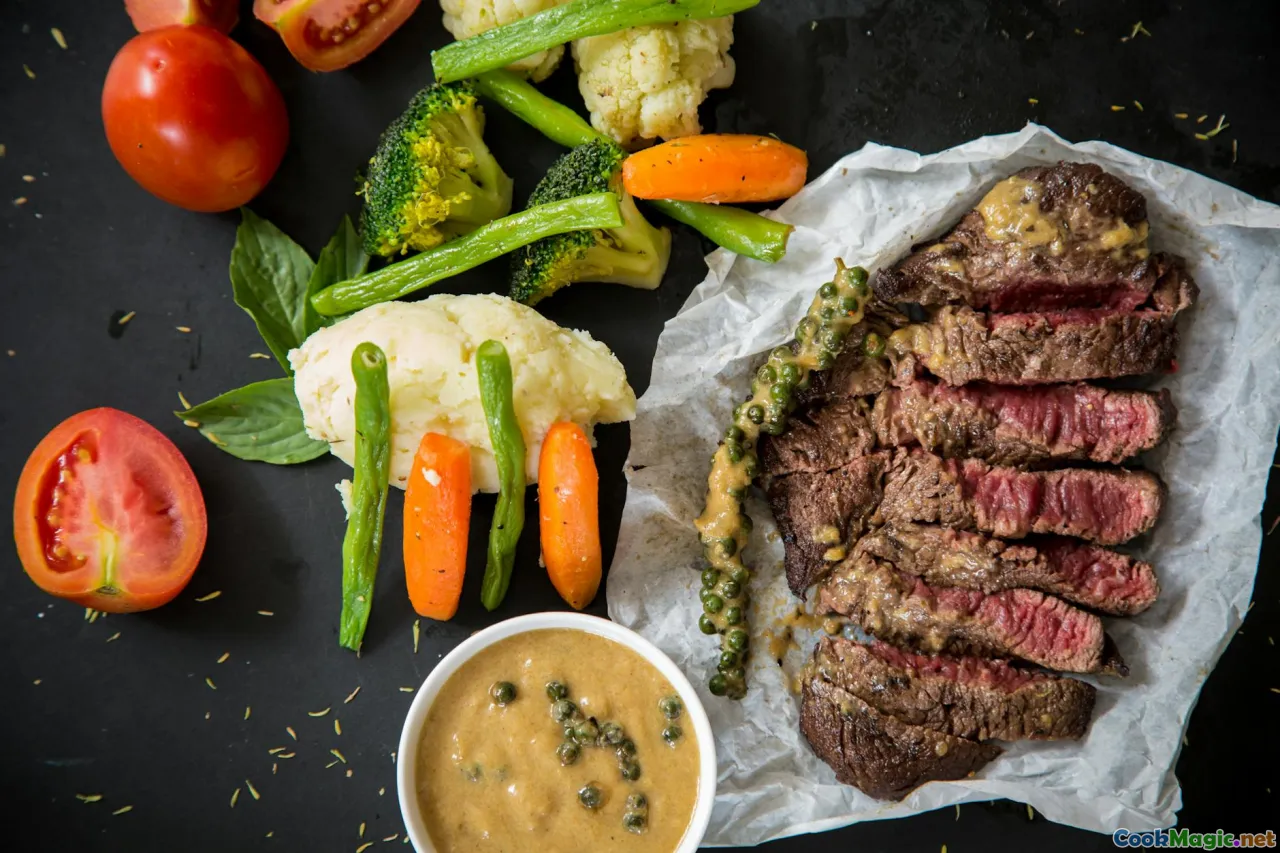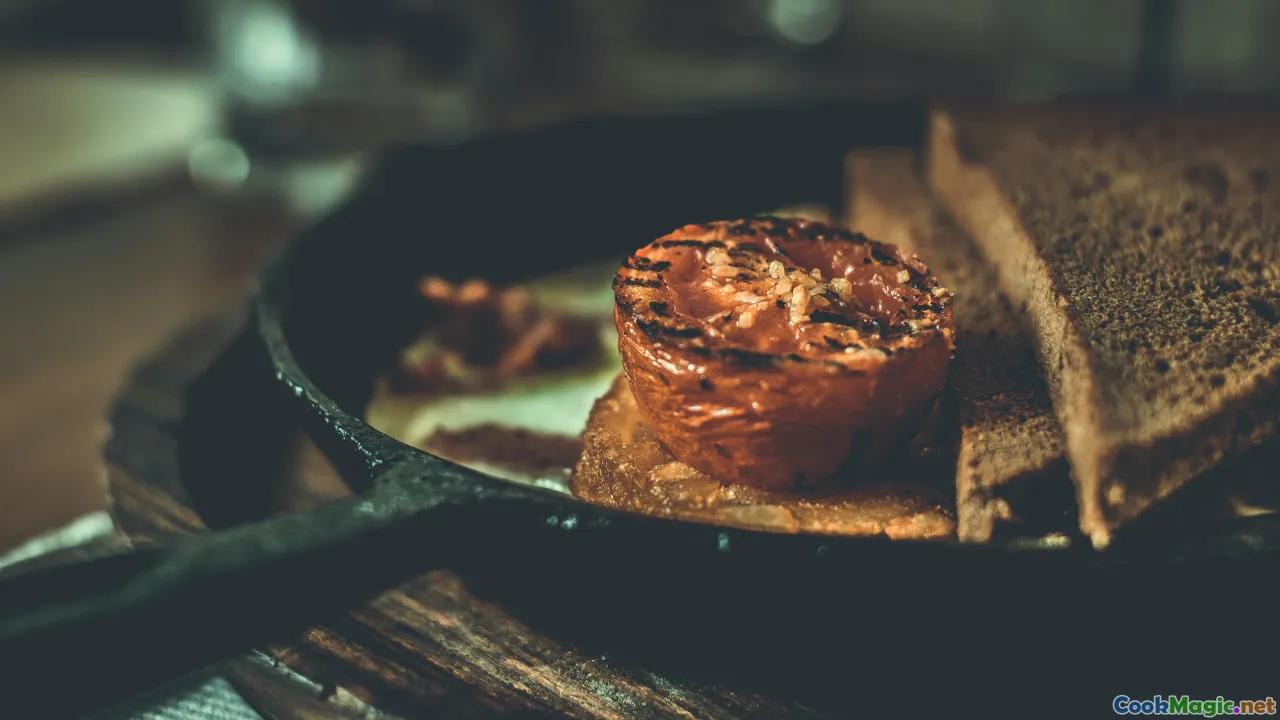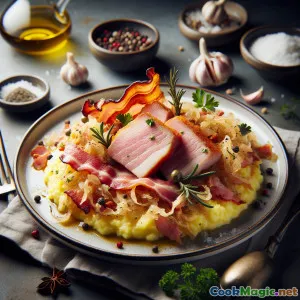
Herzhafte Landpastete mit Rind und Gemüse
(Hearty Country Beef & Vegetable Pie)
(0 Bewertungen)0
937
Juli 18, 2025
Problem melden
Zutaten
-
500 grams Rinderbug
(In 1,5 cm große Würfel schneiden)
-
2 medium Karotte
(Geschält und gewürfelt)
-
1 medium Pastinake
(Geschält und gewürfelt)
-
1 large Lauch
(Gewaschen, halbiert und in Scheiben geschnitten)
-
2 pieces Selleriestange
(Fein geschnitten)
-
2 small Kartoffel
(Geschält und gewürfelt)
-
150 grams Champignons der Sorte Button
(gereinigt und vierteliert)
-
3 cloves Knoblauch
(Gehackt)
-
1 tbsp Frischer Thymian
(Gehackt oder 1 TL getrocknete Kräuter)
-
1 piece Lorbeerblatt
-
120 ml Rotwein
(Trocken; ersetzen Sie bei Bedarf durch Rinderbrühe.)
-
275 ml Rinderbrühe
(Oder Gemüsebrühe)
-
1 tbsp Tomatenmark
-
1 tsp Salz
(Mehr nach Geschmack)
-
0.5 tsp Schwarzer Pfeffer
(Frisch gemahlen)
-
2 tbsp Ungesalzene Butter
(Zum Sautieren)
-
1 tbsp Olivenöl
-
2 sheets Vollbutter Mürbeteig
(Oder hausgemacht (ca. 550 g))
-
1 large Eidotter
(Mit 1 Teelöffel Wasser verquirlt (Eierwaschung))
-
2 tbsp Gehackte Petersilie
(Zur Garnierung)
(In 1,5 cm große Würfel schneiden)
(Geschält und gewürfelt)
(Geschält und gewürfelt)
(Gewaschen, halbiert und in Scheiben geschnitten)
(Fein geschnitten)
(Geschält und gewürfelt)
(gereinigt und vierteliert)
(Gehackt)
(Gehackt oder 1 TL getrocknete Kräuter)
(Trocken; ersetzen Sie bei Bedarf durch Rinderbrühe.)
(Oder Gemüsebrühe)
(Mehr nach Geschmack)
(Frisch gemahlen)
(Zum Sautieren)
(Oder hausgemacht (ca. 550 g))
(Mit 1 Teelöffel Wasser verquirlt (Eierwaschung))
(Zur Garnierung)
Nährwerte
- Portionen: 6
- Portionsgröße: 1 Scheibe (ca. 260 g)
- Calories: 560 kcal
- Carbohydrates: 41 g
- Protein: 28 g
- Fat: 28 g
- Fiber: 6 g
- Sugar: 7 g
- Sodium: 780 mg
- Cholesterol: 82 mg
- Calcium: 85 mg
- Iron: 4.2 mg
Anweisungen
-
1 - Rindfleisch anbraten:
In einer großen Pfanne Butter und Olivenöl bei mittlerer bis hoher Hitze erhitzen. Die Rinderwürfel mit Salz und Pfeffer würzen; portionsweise anbraten, bis sie tief karamellisiert sind. Beiseite stellen.
-
2 - Das Gemüse anbraten:
In derselben Pfanne bei Bedarf mehr Butter hinzufügen. Lauch, Sellerie, Karotten, Pastinake, Knoblauch und Champignons anbraten, bis sie weich und aromatisch sind, ca. 8 Minuten.
-
3 - Ablöschen und köcheln lassen:
Tomatenmark einrühren und eine Minute kochen. Rotwein hinzufügen, dabei die braunen Röststoffe am Boden abschaben, und auf die Hälfte reduzieren. Das Rindfleisch wieder in die Pfanne geben, zusammen mit Kartoffeln, Thymian und Lorbeerblatt.
-
4 - Brühe hinzufügen und schmoren:
Gießen Sie Rinderbrühe hinein. Decken Sie den Topf ab und lassen Sie es bei niedriger Hitze 30-35 Minuten köcheln, bis das Rindfleisch und das Gemüse zart sind und die Flüssigkeit eindickt. Mit Geschmack würzen; vollständig abkühlen lassen.
-
5 - Bereite den Mürbeteigboden vor:
Backofen auf 200°C vorheizen (390°F). Eine 23 cm große Tarteform mit Butter einfetten, mit einem Blatt Blätterteig auslegen, Überschuss abschneiden und die Basis mit einer Gabel einstechen.
-
6 - gefüllte und belegte Pastete:
Verteilen Sie die abgekühlte Rinderfüllung gleichmäßig in der Teigform, wobei Sie das Lorbeerblatt weglassen. Befeuchten Sie die Ränder, bedecken Sie mit dem zweiten Teigblatt, versiegeln und crimpen Sie die Ränder. Schneiden Sie oben eine Dampföffnung ein.
-
7 - Backen:
Bestreichen Sie die Oberseite mit Eigelb. Backen Sie 28–30 Minuten oder bis goldbraun und knusprig. Lassen Sie 8 Minuten ruhen, bevor Sie es aus der Form nehmen.
-
8 - Garnieren und Servieren:
Nach Belieben mit gehackter Petersilie bestreuen. In Scheiben schneiden und warm servieren – mit einem knackigen Salat oder geschmorten grünen Bohnen.
In einer großen Pfanne Butter und Olivenöl bei mittlerer bis hoher Hitze erhitzen. Die Rinderwürfel mit Salz und Pfeffer würzen; portionsweise anbraten, bis sie tief karamellisiert sind. Beiseite stellen.
In derselben Pfanne bei Bedarf mehr Butter hinzufügen. Lauch, Sellerie, Karotten, Pastinake, Knoblauch und Champignons anbraten, bis sie weich und aromatisch sind, ca. 8 Minuten.
Tomatenmark einrühren und eine Minute kochen. Rotwein hinzufügen, dabei die braunen Röststoffe am Boden abschaben, und auf die Hälfte reduzieren. Das Rindfleisch wieder in die Pfanne geben, zusammen mit Kartoffeln, Thymian und Lorbeerblatt.
Gießen Sie Rinderbrühe hinein. Decken Sie den Topf ab und lassen Sie es bei niedriger Hitze 30-35 Minuten köcheln, bis das Rindfleisch und das Gemüse zart sind und die Flüssigkeit eindickt. Mit Geschmack würzen; vollständig abkühlen lassen.
Backofen auf 200°C vorheizen (390°F). Eine 23 cm große Tarteform mit Butter einfetten, mit einem Blatt Blätterteig auslegen, Überschuss abschneiden und die Basis mit einer Gabel einstechen.
Verteilen Sie die abgekühlte Rinderfüllung gleichmäßig in der Teigform, wobei Sie das Lorbeerblatt weglassen. Befeuchten Sie die Ränder, bedecken Sie mit dem zweiten Teigblatt, versiegeln und crimpen Sie die Ränder. Schneiden Sie oben eine Dampföffnung ein.
Bestreichen Sie die Oberseite mit Eigelb. Backen Sie 28–30 Minuten oder bis goldbraun und knusprig. Lassen Sie 8 Minuten ruhen, bevor Sie es aus der Form nehmen.
Nach Belieben mit gehackter Petersilie bestreuen. In Scheiben schneiden und warm servieren – mit einem knackigen Salat oder geschmorten grünen Bohnen.
Mehr über: Herzhafte Landpastete mit Rind und Gemüse
Summary, History & Unique Notes – Tourte Paysanne de Bœuf et Légumes
The „Tourte Paysanne de Bœuf et Légumes“ is the embodiment of French rural comfort food: a robust, golden pastry encasing a rich filling of braised beef and hearty vegetables. Though pies are adored worldwide, in France, savory pies—or 'tourtes'—are traditionally found in both rustic family kitchens and regional patisseries, often serving as testaments to the countryside's bounty and frugal resourcefulness, especially through the winter months when root vegetables are at their finest.
This particular tourte combines tender chunks of beef chuck (a cut favored for its rich flavor and ability to become meltingly soft during braising), a medley of earthy root vegetables such as carrots, parsnips, potatoes, leeks, and mushrooms, all simmered slowly with aromatic herbs and a hint of wine. The filling is then enveloped by a flaky all-butter crust that shatters deliciously with every slice—a texture contrast that defines great French tourtes.
History & Cultural Significance
The roots of the French savory pie reach back hundreds of years, with plenty of historical variations. In the Pays de la Loire, Limousin, and other verdant regions, „tourte“ often references a well-filled double-crust tart. Historically, these pies were convenient ways to use up leftover meats and garden vegetables, stretching small portions over hearty family dinners. The use of beef and robust roots in this recipe makes it a particular fit for colder seasons when the cuisine naturally becomes richer and more filling.
Pies like this were often taken out to the fields as satisfying midday sustenance for peasants (hence 'paysanne'—'peasant style'), convenient to transport and hardy enough to last even without refrigeration. Many French families, particularly in the countryside, still pass down their own variations through generations.
Tips & Notes
- Pie Crusts: You can use a high-quality pre-made all-butter pastry to save time, but if you'd like, roll out your own using the pâte brisée technique. Rest your pastry before rolling for the flakiest results.
- Filling Consistency: Be sure your filling isn't too runny. Letting it cool before adding to the pie shell keeps the pastry crisp and prevents sogginess.
- Vegetable Variations: Substitute or add whatever seasonal veggies you have—rutabaga, celeriac, or turnip also work wonders. Roasting them before stewing adds sweetness.
- Herbs: Thyme, bay, and parsley are classics here, but feel free to add a dash of herbes de Provence for more complexity.
- Wine: The splash of red wine is classic, but if you prefer no alcohol, beef or vegetable broth alone will suffice.
Serving Suggestions & Unique Aspects
Serve piping hot, ideally with sharply dressed greens or glazed garden beans. A glass of light, rustic Bordeaux or a regional Loire red makes for the perfect accompaniment—the wine’s acidity and structure cutting the pie’s richness beautifully. The tourte also keeps well, making excellent leftovers; try it reheated as a hearty work lunch or cold for a French picnic spread.
What sets this 'peasant's pie' apart is its balance—robust yet layered in flavor, rich but countered by gentle herbal notes and the natural sweetness of slow-stewed veggies. Above all, it is a love letter from the French terroir: food meant for sharing, comforting, and uniting around the table.
Chef’s Reflection
Every time I make a tourte like this, I'm reminded of the power of simple, seasonal ingredients cooked slowly and with care. It doesn't rely on expensive cuts of meat or rare seasonings, but wrings extraordinary character from what grows close to home and is readily available. For families seeking tradition and flavor, there are few things better than a slice of this pie on a chilly evening, steam rising in a warm kitchen—bon appétit!
























